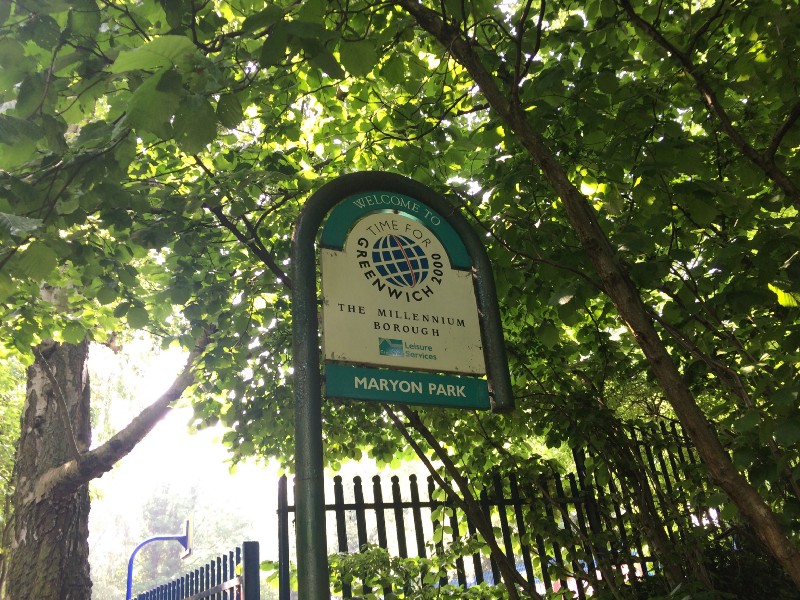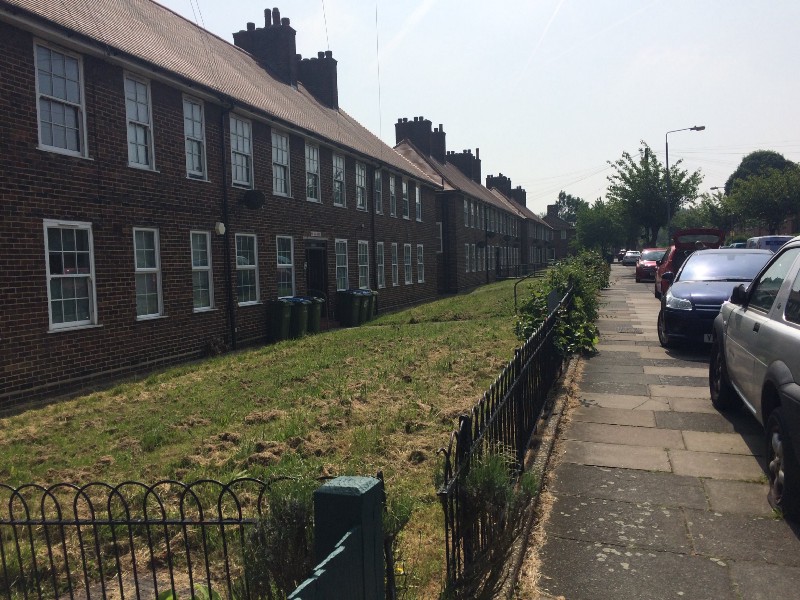Walking round London pt11: Maryon Park to Hornfair Park
Parklife in south-east London: Murder and mime, baronets and birds, peasants and kings
(ICYMI: on Sat 5 May, the writer walked 36km as the first quarter of a 120km circumnavigation of the capital for charity; on Sat 26 May, he walked the next quarter. These blogs are to publicise the fundraising and consider the vernacular. There’s a full list of chapter/sections at the end of each blog.)
After a hard 90 minutes walking various streets (and the occasional tunnel) in increasing heat, Maryon Park represents the start of the green era. From here we’ll be walking through parkland of various types, almost unbroken for the next two hours and representing the vast majority of the walk’s remaining seven hours. As a student of the built environment, there may be less for me to see — but as a human on a hot day, there’s serenity in the shade.
This hasn’t aged well.
We pass under a sign of the past times and over the railway line between Charlton and Woolwich Dockyard stations, more broadly the first of several capital-to-Kent arteries we’ll cross. As the park opens out, fans of 60s cinema may experience a light deja-vu. It’s a fairly typical scene — grass, paths, tennis courts — but it’s the park heavily featured in Antonioni’s Blow Up, in which a Swinging London photographer closely modelled on David Bailey believes he has accidentally documented a murder; the courts are the location of the mimed tennis match at the film’s end.
Following the path of the mimes’ jeep — now there’s an opening clause you don’t type every day — I curve around the edge of what was once a sand pit. Not a child’s play area, but a huge industrial concern: the East Pit, out of which was dug sand for scouring, ballast, glass manufacture or moulding down at the arsenal from the 18th century until just shy of the 20th. Having literally exhausted it, and with the recent Metropolitan Open Spaces Act encouraging the provision of public leisure areas, the owner donated 12 acres to the London County Council in 1889.
Godzuki’s sandpit.
The owner was Sir Spencer Pocklington Maryon Maryon-Wilson, Lord of the Manors of Charlton and Hampstead, 11th Baronet of Eastbourne, and it’s worth us spending a moment in his company. He was the only baronet who insisted on being addressed as ‘Sir Baronet’, and if you thought that odd, he didn’t give a fig. “I don’t care a damn what the world thinks or says about me,” he said in 1938. “I’m looked on as a crank, but I’ve just got moral courage. I’ve seen letters addressed to my butler, my gamekeeper, yes, even my odd man, addressing them as ‘Dear Sir’. Now, why the devil should any baronet be addressed in the same way? A baronetcy is fifth in the noble degree. I and all other baronets have a right to be addressed as ‘Sir Baronet’. My title is 300 years old. It was earned at the risk of the head of my ancestor, who helped Charles II in his restoration.”
Anyway, the donated land was levelled, grassed and reopened as a park in 1891, extending over the next 40 years. A notable extension, to the west, was Gilbert’s Pit, whose exposed strata have yielded fossils and knowledge: it is now a site of special scientific interest. Another pit less than half a mile south-west of here became the site of Charlton Athletic’s ground, The Valley.
Between Gilbert’s Pit and the main Maryon Park is a high embankment which includes the inner ring of earthworks from a Romano-British settlement from the first five centuries AD. I mount the extensive flight of steps thereover; Antonioni’s stylish snapper may have bounded enthusiastically up them, but he wasn’t 6km into a 35km walk.
Ascent is inevitable for those of us en route from riverside to what the Capital Ring route-map ominously describes as “one of the highest points in the area”. Judging by the view that opens up as I cross a road that dips precipitously to either side of me, south-east London has its ups and downs. Having ascended through Maryon Park, I’m immediately descending through Maryon Wilson Park, where there are small enclosures for deer, sheep and various aquatic birds.
Round the corner there’s a patient dad straddling the ever-nervy line between letting his toddlers explore nature and stopping them falling in the stream which flows through this narrow combe. It’s not clear whether they’re responsible for the arrangements of petals spelling out two names, or if it’s a touching, if ephemeral, lovers’ bond.
Cresting the combe and crossing a road, I realise I seem to have lost all of my fellow walkers: some are in front, some behind, but none are in sight. And that’s fine: while conversation is pleasant, it’s also good on occasion to be left to one’s own thoughts in enjoyable solitude, particularly in such a metropolis.
I’m soon in Charlton Park, considerably more mass-market municipal than the previous two greenlands: play-parks, pleasant cafés and dozens of football pitches, a surprising number of them covered in players whose fluorescent bibs denote either training sessions or well-organised scratch matches.
It’s now nearly 11am and increasingly warm in full sunshine, but the limbs whirl: these could be post-season try-outs for new teams, or exit trials, but there seems no lack of effort. Down at the younger, less formal end, one top-knotted coach encourages a gaggle of not entirely slender kids to “keep running” between mouthfuls of his somewhat authority-undermining cheese toastie, but at least they’re all giving it a go.
Just further on, in front of the tempting Old Cottage café, I’m pleased to see an eight-a-side game between oranges and lemons, the well-mannered young participants having thoughtfully arranged their cones-for-goalposts into unusually narrow targets: it improves ability by deprioritising power, which is a temporary arrangement of muscular supremacy, for accuracy, a technique which will remain for life.
Eight-a-side on a Jacobean lawn.
They’re playing in the grounds of Charlton Park House, built 1607–1612 on the orders of James Stuart, the Scottish king who had recently been invited to knock through into next door when Elizabeth Tudor died heirless (and possibly hairless). There aren’t many Jacobean houses left and perhaps this is one reason Charlton House seems peculiar: somewhere between the sprawling Tudor style and the neater, more classically organised architecture to come.
One of the main progenitors of that neatness was Inigo Jones, whose name adorns a nearby street up which I now trudge. (Although some deny it, Jones is claimed to have designed the Charlton House orangery which was converted in 1937 to a public toilet.) It’s hard to imagine how such a neoclassicist would have reacted to Inigo Jones Road, which seems a perfectly ordinary 1930s suburban estate street with one exception: its windows seem inordinately large.
Inigo Jones Road. Note arrows, including the Green Chain Walk our path is largely following.
Now, I’m not one to deny the right to light: I live in a 1960s house with wall-to-wall windows and can often be found shaking my head sadly at the minuscule casements afforded to many modern houses, as if glass were still a luxury. But these seem perversely enormous, like the googly eyes of an anime character. Perhaps it’s the sham-posh lattices — not structural mullions or transoms, but needless decorative strips more correctly called grilles — or maybe they’re precisely the wrong size to be in scale, but it’s hard to imagine Inigo impressed.
Is it me?
After that brief Inigovian interlude we’re back on parkland, this time Hornfair Park. At first sight, this seems your typical park: pitches, paddling pool, hard-court tennis, playground and a popular BMX track — but this place has a somewhat louder history.
From the Old English, Charlton means “farmstead of the freeman peasants”; the first syllable also gives us churlish, an adjective which has evolved beyond its origin noun to mean deliberately surly, rude and objectionable, as if the ancients foresaw Twitter. And by the early 18th century, Daniel Defoe — no church mouse himself, as I’ve mentioned in an earlier piece — was moved to describe Charlton in A Tour Through Great Britain as:
“A village famous, or rather infamous, for the yearly collected rabble of mad-people, at Horn-Fair; the rudeness of which I cannot but think, is such as ought to be suppressed, and indeed in a civiliz’d well govern’d nation, it may well be said to be unsufferable. The mob indeed at that time take all kinds of liberties, and the women are especially impudent for that day; as if it was a day that justify’d the giving themselves a loose to all manner of indecency and immodesty, without any reproach, or without suffering the censure which such behaviour would deserve at another time.”
At Hornfair I find no impudent women, just more walkers: after 30 minutes of solo adventure I catch up with my pink-shirted kind at the first of three checkpoints, offering food, drink, first aid and encouragement. It’s just past 11am, two hours and 9.5km into the walk, and much more lies ahead.
Nuts. (Pic credit: Mencap)
Coming up next: Matters military
The Mencap Capital Challenge is a charity walk circling London in four quarters, each roughly 30km. You can donate or sponsor the writer at justgiving.com/garyparkinson1974. You can also join in: the South quarter (Crystal Palace to Richmond) will take place on Sat 9 June, the West quarter (Richmond to Hendon) on Sat 7 July.
NORTHERN QUARTER, SAT 5 MAY 2018
• Pt1: Wembley to East Finchley • Pt2: …to Finsbury Park
• Pt3: …to Clissold Park • Pt4: …to Springfield Park
• Pt5: …to Hackney Wick • Pt6: …to Bow Back River
• Pt7: …to Channelsea River • Pt8: …to Royal Victoria Dock
EASTERN QUARTER, SAT 26 MAY 2018
• Pt9: Victoria Dock to North Woolwich Pier • Pt10: …to Maryon Park
• Pt11: …to Hornfair Park • Pt12: …to Oxleas Wood
• Pt13: …to Eltham Palace • Pt14: …to Grove Park
• Pt15: …to Beckenham Place Park • Pt16: …to Penge
• Pt17: …to Crystal Palace Park • Pt18: …to Upper Norwood
SOUTHERN QUARTER, SAT 9 JUN 2018
• Pt19: Crystal Palace to Beulah Hill • Pt20: …to Streatham Common
• Pt21: …to Tooting Bec • Pt22: …to Wandsworth Common
• Pt23: …to Wimbledon Park • Pt24: …to Richmond Bridge
WESTERN QUARTER, SAT 7 JUL 2018
• Pt25: Richmond Bridge to Isleworth • Pt26: …to Hanwell Locks
• Pt27: …to Horsenden Hill • Pt28: …to Sudbury Hill
• Pt29: …to Wembley, and that's that














